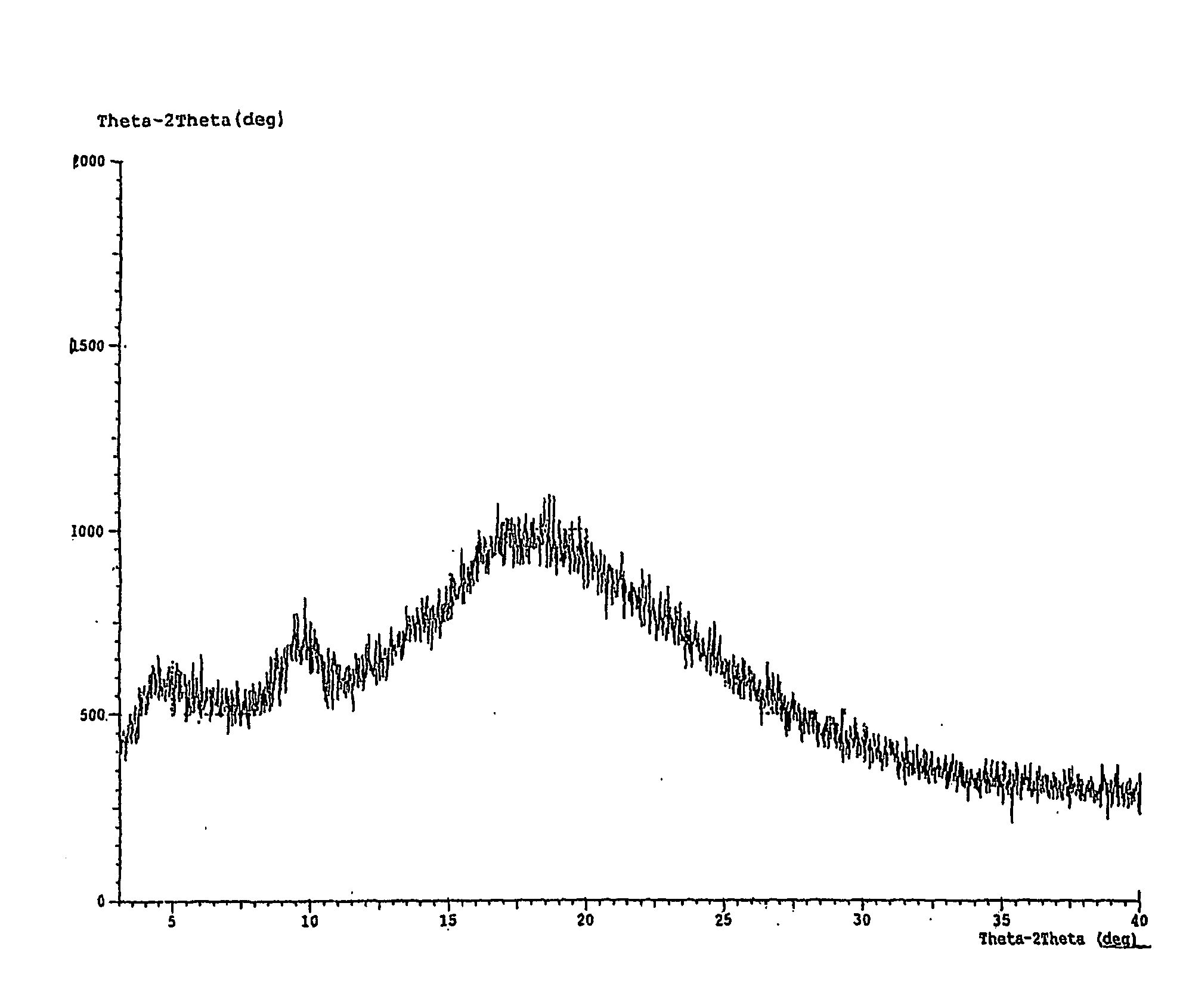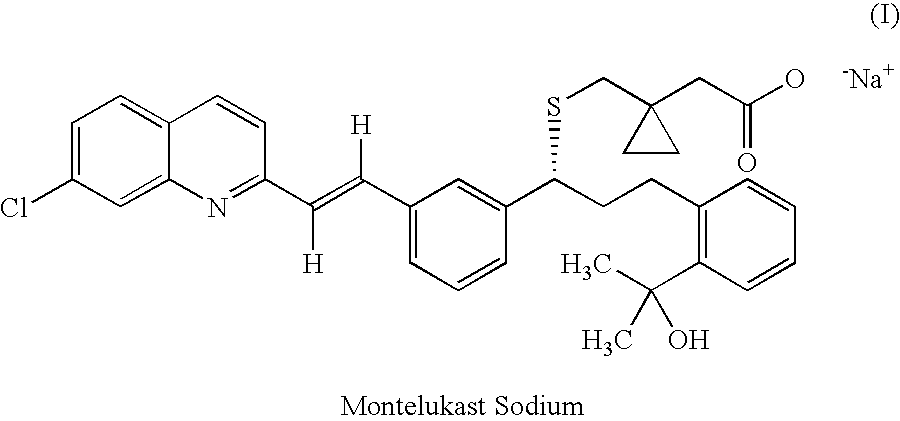Method for the preparation of montelukast acid and sodium salt thereof in amorphous form
a technology of montelukast and sodium salt, which is applied in the field of improved methods for the preparation of montelukast acid and its sodium salt, and the method for the preparation of amorphous montelukast sodium, can solve the problems of obvious long process as well as tedious, capital-intensive freeze-drying equipment, and proves commercially expensive if not unviabl
- Summary
- Abstract
- Description
- Claims
- Application Information
AI Technical Summary
Benefits of technology
Problems solved by technology
Method used
Image
Examples
example-1
[(S)-(E)]-2-[2-[3-[3-[2-(7-Chloro-2-quinolinyl)ethenyl]phenyl]3-methanesulphonyloxy]propyl]phenyl]-2-propanol (VIII)
[0066] To a 2.0 lt. / 4 neck round bottom flask fitted with a mechanical stirrer and thermometer inlet were successively charged diol (VII) (75.0 g, 0.16 mol), toluene (225 ml) and acetonitrile (600 ml) under an atmosphere of nitrogen gas at +25 to +35° C. After stirring for approximately 10 minutes, N,N-diisopropylethylamine (23.29g / 30.90 ml, 0.18 mol) was added over a period of 5 minutes. The solution was cooled to −30 to −25° C. in a liquid N2 / methanol bath, methanesulphonyl chloride (33.0g / 22.5 ml, 0.29 mol) was added drop wise over a period of 15 minutes, keeping the temperature at −30 to −25° C. and stirred for 5 hrs at this temperature. During this period, thick off white to pale yellow solid had precipitated out. The reaction mixture was further cooled to −30 to −40° C., product (VIII) was carefully filtered, successively washed with chilled acetonitrile (−30° C...
example-2
[(R)-(E)-1-[[[-1-[3-[2-(7-Chloro-2-quinolinyl)ethenyl]phenyl]-3-[2-(1-hydroxy-1-methyl ethyl)phenyl]propyl]thio]methyl]cyclopropaneacetic acid dicyclohexylamine salt (X)
[0069] Step 1
[0070] n-Butyl lithium (195 ml, 1.6 Molar solution in hexanes, 0.312 mol.) was slowly added to a cooled (−15 to −10° C.) solution of 1-(mercaptomethyl)cyclopropaneacetic acid (IX) (23.25 g, 0.16 mol.) in dry THF (385 ml.) in a 1 lt. / 4 neck round bottom flask fitted with a mechanical stirrer and a thermometer inlet under nitrogen atmosphere and the mixture was stirred for 30 minutes at −15 to −10° C.
[0071] Step 2
[0072] To a separate a 1.0 lt / 4 neck round bottom flask equipped with a mechanical stirrer, thermometer inlet and under dry nitrogen gas atmosphere was placed THF (385 ml) and the solvent was cooled to −10 to −5° C. The wet monomesylate (VIII) (77.0 g, 0.144 mol / amount calculated on dry basis after LOD analysis) was added via a powder funnel and the mixture was stirred for 15 minutes at −10 to...
example-3
[(R)-(E)-1-[[[-1-[3-[2-(7-Chloro-2-quinolinyl)ethenyl]phenyl]-3-[2-(1-hydroxy-1-methylethyl)phenyl]propyl]thio]methyl]cyclopropaneacetic acid (Pure VI)
[0082] To a stirred suspension of montelukast DCHA salt (X) (80.0 g, 0.104 mol, purity 98.06%, assay=97.50.%), in toluene (800 ml.) and DM water (800 ml.) at +25 to +35° C., acetic acid (2.0 Molar soln., 80 ml.) was charged over a period of 30 minutes and the mixture was stirred for another 15 minutes at +25 to +35° C. The toluene layer was separated, washed with water (800 ml). The toluene layer was separated, seeded with crystals of pure (VI) and stirred at +25 to +35° C. for 5-6 hrs. The resulting solid was filtered, washed with toluene (160 ml) and dried at +40 to +45° C. under vacuum to yield pure montelukast acid (VI) as a light yellow solid. Yield=37.0 g (60.54%); Purity (HPLC)=98.95%; Assay (HPLC)=99.01%; Melting point=148-150° C.
[0083] IR (KBr, cm−1)=3573.1, 2988.2, 2919.6, 1716.0, 1606.7, 1500.1, 1407.8, 1076.0, 842.3, 766...
PUM
| Property | Measurement | Unit |
|---|---|---|
| Temperature | aaaaa | aaaaa |
| Temperature | aaaaa | aaaaa |
| Temperature | aaaaa | aaaaa |
Abstract
Description
Claims
Application Information
 Login to View More
Login to View More - R&D
- Intellectual Property
- Life Sciences
- Materials
- Tech Scout
- Unparalleled Data Quality
- Higher Quality Content
- 60% Fewer Hallucinations
Browse by: Latest US Patents, China's latest patents, Technical Efficacy Thesaurus, Application Domain, Technology Topic, Popular Technical Reports.
© 2025 PatSnap. All rights reserved.Legal|Privacy policy|Modern Slavery Act Transparency Statement|Sitemap|About US| Contact US: help@patsnap.com



